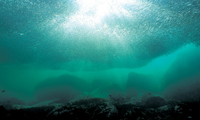Climate
- Temperatures
- Yearly average 12°C
- January average 1°C
- August average 23°C
- Rainfall
- Yearly average 1,240mm
- Typically maritime climate with influences of warm currents.
- Frequent fog covers with more than 160 days of cloud cover and approximately 150 days of rain a year.
Dokdo’s climate is typical oceanic climate largely influenced by temperate currents, with the average temperature around 12°C. Dokdo is considered relatively warm, as its average temperature in the coldest month (January) is 1°C and that of the hottest month (August) is 23°C. Dokdo is generally very windy with the average wind velocity at 4.3m/s. The wind blows mostly from the southwest in summer and from the northeast in winter.
Dokdo is classified as a relatively humid region with frequent fog covers, 160 or more days of cloud cover a year, and some 150 days of rain. It is either raining or snowing for almost 85% of the year in Dokdo. Dokdo’s annual average precipitation is approximately 1,240mm, snow being the usual winter precipitation, and heavy snowfall is typical for the region.
The waters surrounding Dokdo are located on the southern side of a polar front that forms a border between the warm currents from the south and the cold currents from the north. The waters surrounding Dokdo are largely influenced by the warm currents for the most part of the year, and the surface layer temperature stays between 9 to 25℃ year round.
Topography
Dokdo consists of volcanic islets formed by hardened lava which erupted about 2,000m underwater. It was formed between the early and the late Pliocene Epoch in the third phase of the Cenozoic Era, between about 4.6 million and about 2.5 million years ago. Considering that Ulleungdo was formed about 2.5 million years ago, Dokdo is about 2 million years older than Ulleungdo.

Geology
Dokdo is composed of alkali volcanic rocks formed by volcanic activities, namely basalt and trachyte. Its soil is residual, weathered from the peak of the mountains, lying on steep slopes of over a 30° grade. The sandy loam is dark or reddish brown in color.
Dokdo is Korea’s easternmost set of islets with a maritime climate generally considered warm and humid. However, thanks to its clear seasonal divisions and its location where cold and warm currents cross, Dokdo boasts one of the most diverse and unique ecologies in all of Korea.
Plant Ecology
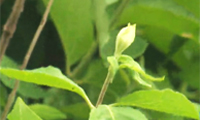
< Lonicera insularis >
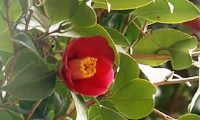
< Camellia >
Dokdo’s climate is relatively warmer than regions situated on the same latitude according to its mathematical location, and is humid due to frequent exposure to sea fog. Dokdo’s flora therefore is similar to those of subtropical regions. Formed of volcanic rocks, Dokdo does not provide the most ideal conditions for plant growth. Rain water does not get stored in the soil due to the islands’ steep slopes, so the soil remains relatively dry. High salinity and lack of fresh water make Dokdo less than ideal for the settlement of any plant life as well. Therefore most plants seen in Dokdo are short-rooted herbaceous plants (annual or biennial plants with soft stems). However, despite such an environment, researches show some 50~60 different types of plants currently growing on Dokdo.
Trees (perennial plants with thick, hard stems) native to Dokdo include Lonicera insularis, Euonymus japonica, Elaeagnus macrophylla, Cocculus trilobus, ampelopsis and Camellia japonica. Lonicera insularis is a rare breed found only in Ulleungdo and Dokdo. This tree grows to be about 1.5~2m tall and 20cm in girth. The trees form forests, and those found in Dokdo are especially short, well-adjusted to the strong maritime winds, with thick, pubescent leaves which help the trees withstand droughts and cold temperatures.
Dokdo’s flora have been researched and studied on more than 30 different occasions so far, but the findings varied greatly, from as little as 34 different species to as many as 75.
Avian Ecology

< Black-tailed gulls >
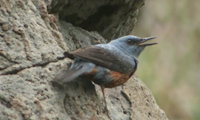
< Fork-tailed petrels >
Dokdo’s fauna is divided largely into birds, insects and mammals. There has yet to be any report of amphibians or reptiles being found on Dokdo.
Birds native to Dokdo include black-tailed gulls, fork-tailed petrels, swans, harlequin ducks, bramble finches, yellow-throated buntings, white-faced wagtails, golden-crested wrens, snipes, kestrels, shearwaters and quails. The largest in number are the black-tailed gulls, fork-tailed petrels and shearwaters in that order, while 8 species, namely the hawks, honey buzzards, kites, crested murrelets, owls, ospreys, swans and hooded cranes are considered endangered. Black-tailed gulls, fork-tailed petrels and shearwaters, seen only in Northeast Asia, nest in colonies on Dokdo. While the number of fork-tailed petrels and shearwaters are on the decline, approximately 2,000~3,000 black-tailed gulls are estimated to inhabit the islands. The Southern slope of Seodo, and the western side of Dongnimmunbawi, where the perennial grass Elymus tsukushiensis Honda grow, are known as the great nesting grounds of black-tailed gulls.
Meanwhile, Dokdo also acts as a rest stop for various migratory birds traveling north to south. Dokdo was designated as ‘Dokdo Seabird Breeding Grounds’ on November 16, 1982, and when Dokdo was later designated as Natural Monument No. 336, the title was changed to Dokdo Natural Ecosystem Reservation Area as of December 1999.
Insects of Dokdo
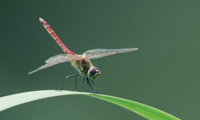
< Dragonflies >
Some 53 species of insects belonging to 35 families under 9 orders, including dragonflies, earwigs, cicadas, beetles, flies and butterflies are known to inhabit Dokdo, although research results vary. Due to the relatively warm climate caused by the temperate ocean currents and seasonal winds, southern characteristic insects (50.9%) outnumber northern characteristic insects (39.7%). It is hypothesized that these insects have arrived on the islands on the movements of the Kuroshio Current and the Tsushima Warm Current. More than 90% of Dokdo’s insect fauna are those in common with insects found on the mainland, while 70% are in common with those found on Ulleungdo. Only 3 insect species are indigenous to Dokdo, making up about 8% of the total. Such findings suggest that Dokdo is closely linked to the Korean Peninsula, and that like vegetation, insects migrated from the peninsula to Ulleungdo, then to Dokdo. Meanwhile, species previously unrecorded in Korea, such as Campylomma lividicorne, Agrypnus miyamotoi, Ancylopus melanocephalus and Pseudozizeeria maha, were found in Dokdo, drawing much scholarly attention.
Mammals of Dokdo
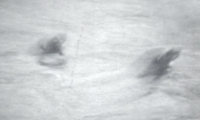
< Sea lion >
There are no wild mammals currently inhabiting Dokdo. Only a number of Sapsal dogs (a shaggy dog breed indigenous to Korea) are kept by the Dokdo Guards. In the past, numerous sea lions (marine mammals) lived on rocks near Dokdo, but they are now rarely seen after the Japanese colonization, during which they were overhunted for hide and oil. In 1973, the Dokdo Guards brought 10 rabbits onto the island and set them free. When the number of rabbits multiplied and caused various problems, such as destruction of the plant ecology, the rabbits were removed from the island. Considering the environmental characteristics of islands, introduction of foreign animals and plants require careful approaches.
Marine Ecology
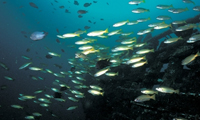
Recently magnified territorial issues regarding Dokdo have also been casting spotlights on the characteristics of Dokdo’s marine ecology, resulting in a reevaluation of the values of marine resources from waters surrounding Dokdo. Research on the ecosystem and resources in the waters around Dokdo have been conducted on several occasions, but research on its marine ecology began in earnest only in 1997. In addition, the Dokdo Research Center was recently founded, and has been collecting data on the basic ecology, through studies including annual underwater research.
Similar to Ulleungdo, Dokdo is influenced by the Tsushima Warm Current and therefore many warm-water organisms can be observed. As the water temperatures can drop below 10℃ in winter, cold-water organisms are also found in the same waters, which is a feature common to seas where warm currents and cold currents collide. Because of this, waters surrounding Dokdo display unique marine ecological features, different from those of the East Sea, South Sea or waters of Jeju Island. This makes Dokdo and its surrounding waters very important from an ecological point of view. Marine ecology research conducted since 1997 has selected 5 different areas to represent different underwater topographies. These regions were then divided again according to types of organisms, and distribution, structure, ecology and current numbers of sea algae, invertebrates, and fish were estimated. The distribution of these organisms was found to vary according to location, depth, topographical features and seasonal differences.
Other Ecosystems
To this day, around 160 different sea algae have been identified along the coasts of Dokdo, including large brown seaweed types such as Eisenia bicylis, Ecklonia cava and Undaria pinnatifida. The number of invertebrates differs per research, but roughly 32 types of Polychaeta, 6 different Anomura, 64 types of mollusks show that warm-water animals and cold-water animals live mixed together. A total of 58 different types of fish were identified and recorded in the waters off of Dokdo in 1997, but 19 more were identified in addition since, with the total standing at 77. Thirty-seven percent of the fish around Dokdo are tropical fish, 22% are subtropical and 40.2% are temperate fish. There are more temperate fish around Dokdo compared to the southern coasts of Jeju Island, and this is because of the collision of the warm currents and the cold currents around Dokdo.








